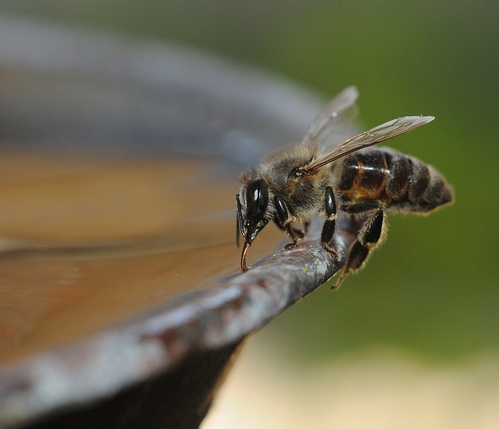Bee health.
So crucial.
The January newsletter published by the eXtension.org Bee Health Community of Practice includes:
* New Feature: Managed Pollinator CAP Updates
* Social Media Strategy Developed
* YouTube Channel Launched
* New Feature: University of Florida Bee Disease Videos
* FAQ's Organized by Category
* Google Analytics: Bee Health Homepage in Top 10 at eXtension.org
* On the Calender
One of the many bee experts who answers the Frequently Asked Questions (FAQs) is John Skinner of the University of Tennessee, who has strong UC Davis connections. He received his doctorate in entomology from UC Davis in 1987, studying with major professor and native pollinator specialist Robbin Thorp. Although an emeritus professor since 1994, Thorp continues his research. He maintains an office in the Harry H. Laidlaw Jr. Honey Bee Research Facility, UC Davis.
Here's a sampling of the questions that Skinner answered in the last few months:
How Do Bees Make Wax?
Bees produce the beeswax used in the construction of their combs from the four pair of wax glands located on the underside of the abdomen. These glands are most highly developed and active in bees 10-18 days old. The wax appears in small, irregular oval flakes or scales that project between the overlapped portions of the last four abdominal segments. Wax can be secreted only at relatively high temperatures and after a large intake of honey or nectar. --John Skinner, University of Tennessee
How Do Bees in a Swarm Determine Where to Go for a New Home?A swarm of bees hanging on a branch includes a queen and thousands of worker bees. Some of these bees function as scouts and search the surrounding area for a suitable category to move into. The scouts return to the swarm cluster and dance to communicate information to the bees in the swarm. There may be numerous dances all going on at the same time. The results are similar to a dance contest where the number of dances is reduced until only one dancer left. Within a half hour of reaching an “agreement” the swarm flies to the new location. --John Skinner, University of Tennessee
How Long Do Honey Bees Live?During the active season, the lifetime of a worker is five to six weeks. Overwintering worker bees may, however, live for four to six months. Whatever their life span, worker bees usually confine themselves to one task at a time, working without pause. If they are field bees, they may be scouts or collectors. Scouts look for sources of nectar and pollen. Once suitable sources are located, the scouts recruit additional foragers.
Nectar collectors, pollen foragers, water gatherers or propolis gatherers work so single-mindedly at their jobs, they will not stop even to collect honey placed before them. During the day, one may see hundreds of spent workers, wings ragged, returning wearily to the hive. Worker bees are aptly named as they literally work themselves to death. Death occurs following approximately 500 miles of flight. --John Skinner, University of Tennessee
How Can Worker Honey Bees Perform So Many Tasks in Their Short Lives?The lives of the worker bees fall roughly into two periods. During the first period of approximately three weeks, they are called hive or house bees. On emerging from their cells, they groom themselves and engorge on honey and pollen from the storage cells. Their first three days are spent cleaning out brood cells. Thereafter as they mature, glands including labial, salivary, hypopharangeal and wax become functional they feed the older larvae and then the younger larvae, take orientation flights, evaporate nectar, build comb, feed the queen and the drones, keep an even temperature in the brood nest and guard the entrance to the hive. These differences in responsibilities based on worker age are known as a division of labor. But, depending on specific circumstances, it can be very flexible.
The last half of a worker bee’s adult life is devoted to foraging duties outside the hive. Four necessary items collected outside the hive are pollen, nectar, water and propolis (bee glue).--John Skinner, University of Tennessee
Got a question? Just ask it on this page.Another noted bee expert connected with the "Bee Health" Web site is Extension Apiculturist Eric Mussen, member of the UC Davis Department of Entomology faculty. Read some of his answers to FAQs posted on the Harry H. Laidlaw Jr. Honey Bee Research Facility Web site.
It's all about keeping our bees healthy.
Attached Images:

Trio on Sedum

Collecting Water